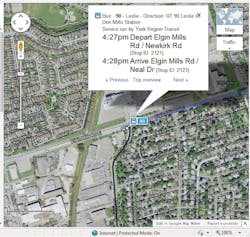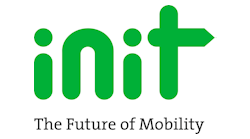It’s no secret Google has cornered the market on … just about everything. Take for instance Google Wallet, an app that allows you to store and use your credit cards on your smartphone and make payments by simply tapping your phone to a NFC (near field communication) terminal — a technology already being used for public transit fare payments in China and Europe.
And then there’s Google Transit, which may very well be the most significant public transit app introduced to date. Google Transit gives agencies the ability to integrate schedule and route information into Google Maps; a welcome and helpful tool for public transit users. This means that agencies no longer expect passengers to understand their system or find their website; instead they are providing the information through a tool passengers already use and understand — Google Maps.
But even Google Transit schedules are rendered useless if changing traffic and weather conditions leave riders waiting in the cold. So, in 2011, Google launched Live Transit Updates. Live Transit Updates gives real-time transit updates to users of Google Maps and Google Maps for mobile. These updates include live departure and arrival times to transit stations, as well as service alerts.
Google Live Transit Updates is a service providing real-time transit updates to users of Google Maps and Google Maps for mobile. These updates include live departure and arrival times to transit stations, as well as service alerts.
Initially six cities implemented Google’s Live Transit Updates: Boston, Portland, San Diego, San Francisco, Madrid and Turin. Shortly after the success of these test projects, York Region Transit (YRT/Viva) — who had already been working with Google since 2008 to provide schedule information to Google Maps — became the first Canadian agency to implement the service. The partnership required the use of YRT’s real-time bus location data which is generated by the GPS-based fleet management system from INIT, Innovations in Transportation Inc.
So, how does Google Live Transit Updates work?
Simply put, riders can access their trip plans and real-time bus departure information for a particular stop by entering a starting address and destination, then clicking on the public transit icon in Google Maps. To access the real-time bus departure information for a particular stop, riders click on the transit stop icon. The information riders get next is not a static “when the bus is supposed to arrive” time, but live departure and arrival times. No more standing in the cold waiting on a bus!
Rajeev Roy, manager of transit management systems at YRT called the service “innovative.” Unlike SIRI (service interface for real-time information), another interface that agencies use to get real-time information to their customers, Google Live Transit Updates is incorporated with Google Maps, not an agency website or app. And, it is being pushed out to everyone through a widely used and preferred site.
“The significance of being the first — and currently only — transit agency in Canada to offer Live Transit Updates is huge. We have the ability to provide an exclusive service that is on the cutting edge of real-time technology within our industry,” Roy said.
Like Google, YRT/Viva has continued to stay on the leading edge of state-of-the-art technologies for public transit today. As a testament to their forward-thinking approach, the agency has received several awards over the years, including “IT Project of the Year” awarded by the Tri-Committee of Ontario in 2007. The honor was bestowed upon the agency for the technology (also supplied by INIT)deployed on their BRT project, Viva, which boasts onboard computers, passenger information displays, next-stop announcements and real-time information signage at the stops to name a few of the many features.
Today, YRT continues to implement new and innovative tools for their customers. Live Transit Updates is just the latest in what’s sure to be an ongoing quest to keep riders in the know and on the move.
The real-time Google trip planner complements YRT/Viva’s existing suite of trip planning services available on www.yrt.ca.
Written by Ann Derby, director of marketing & Events at INIT.




